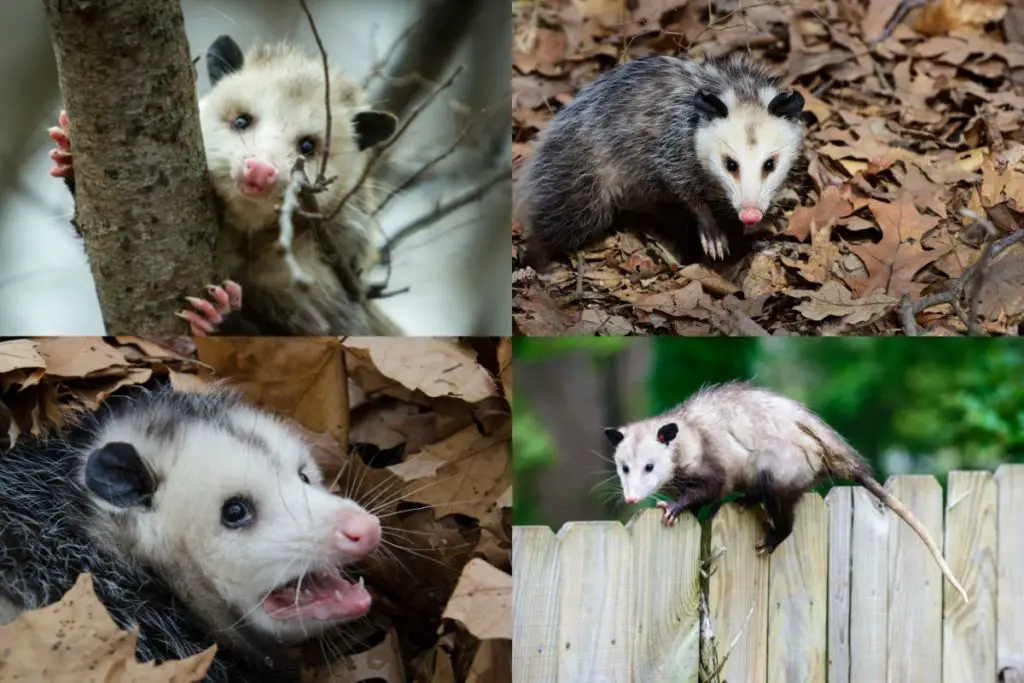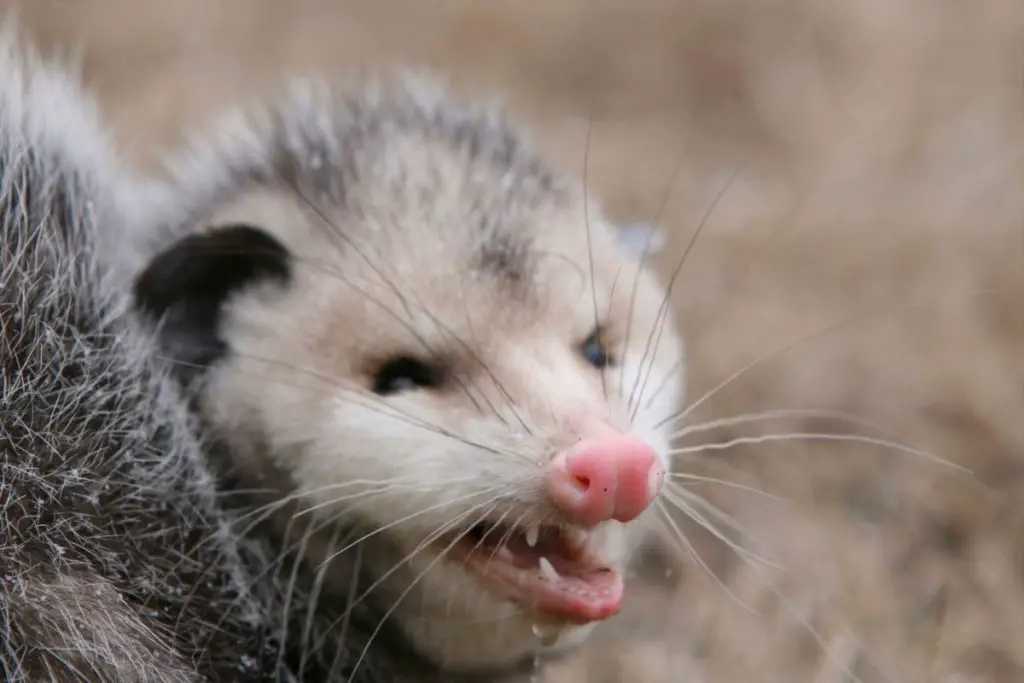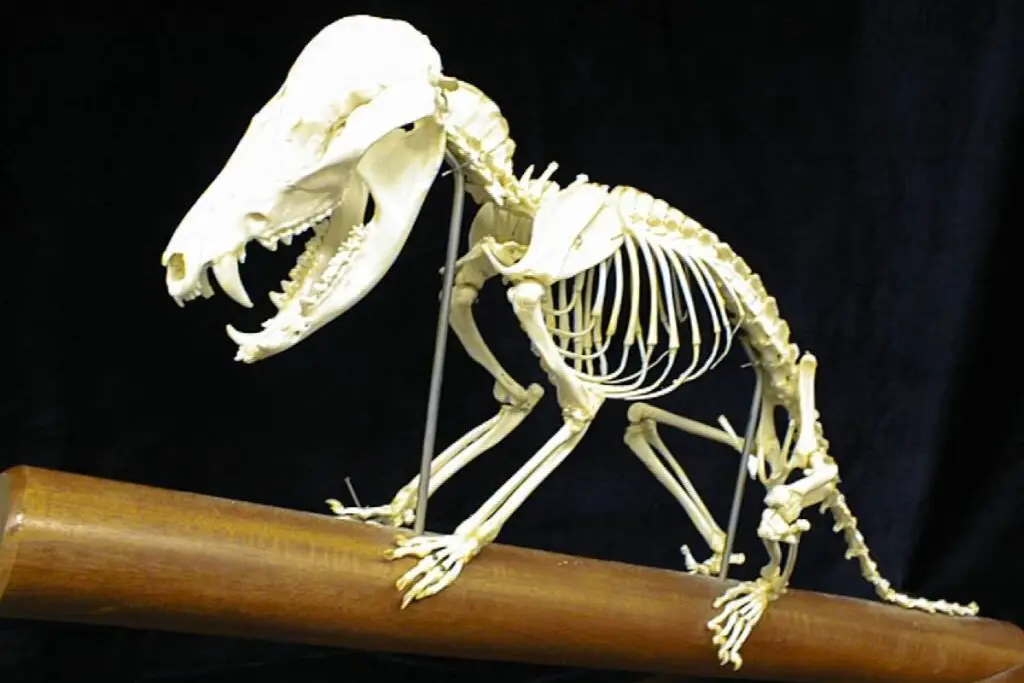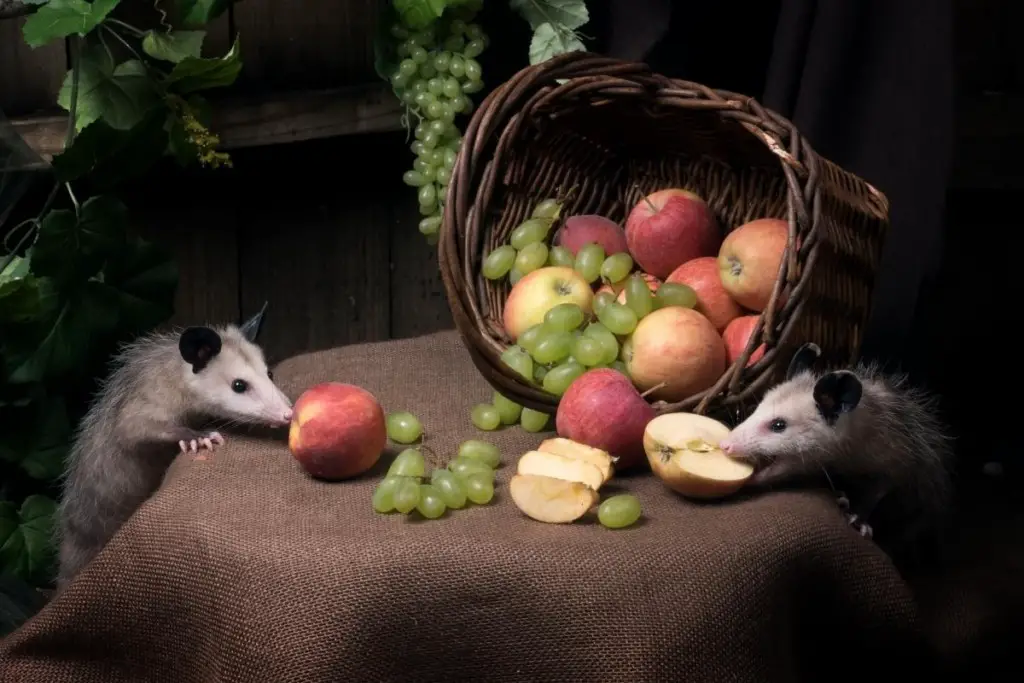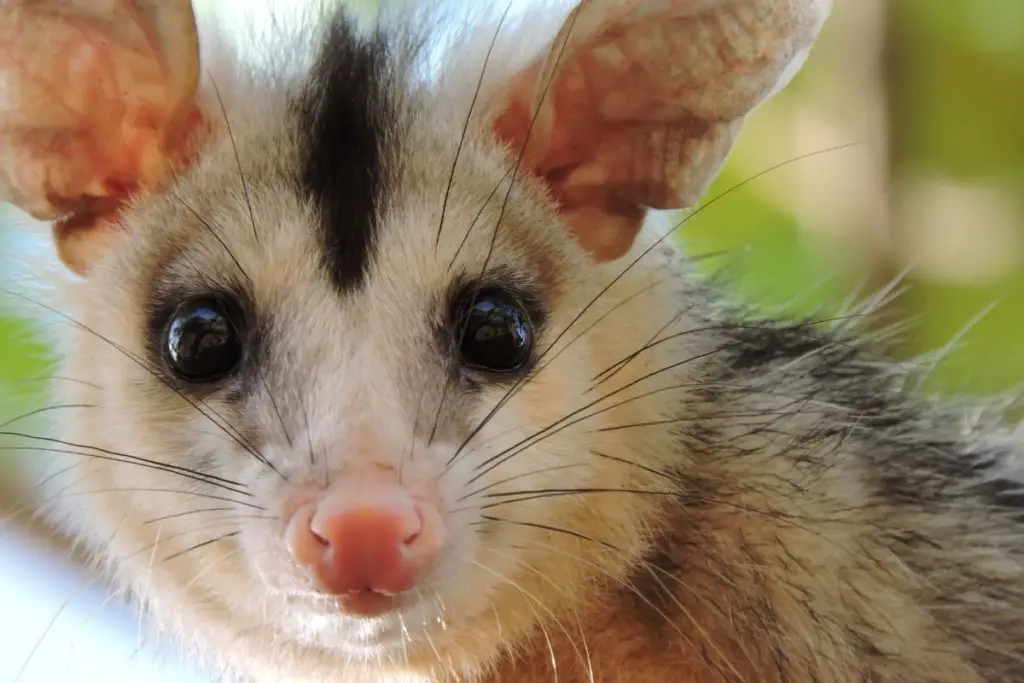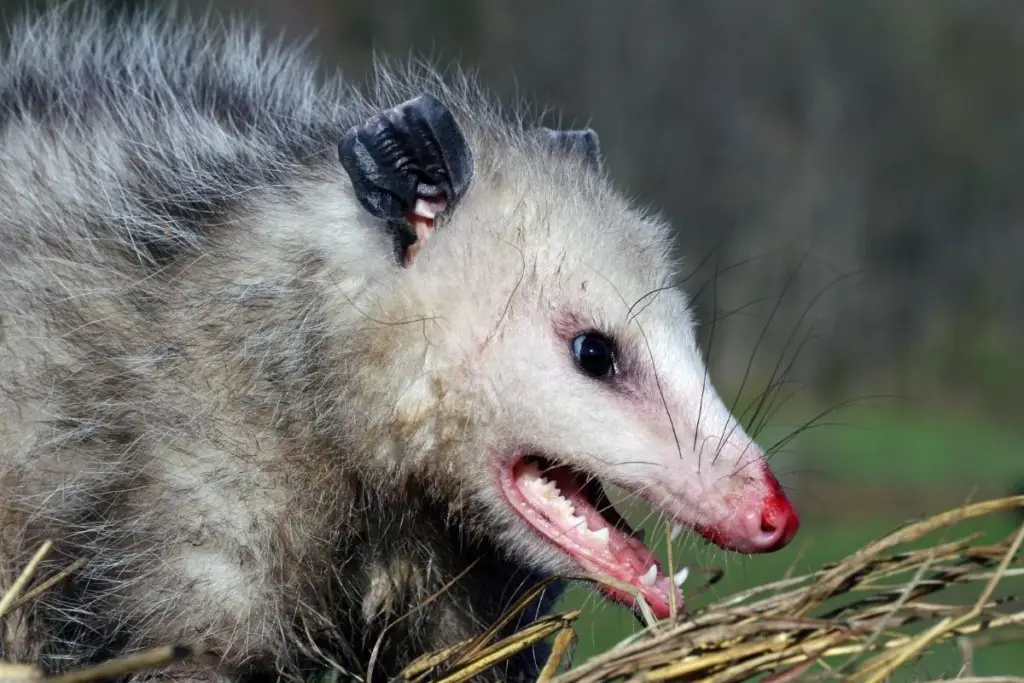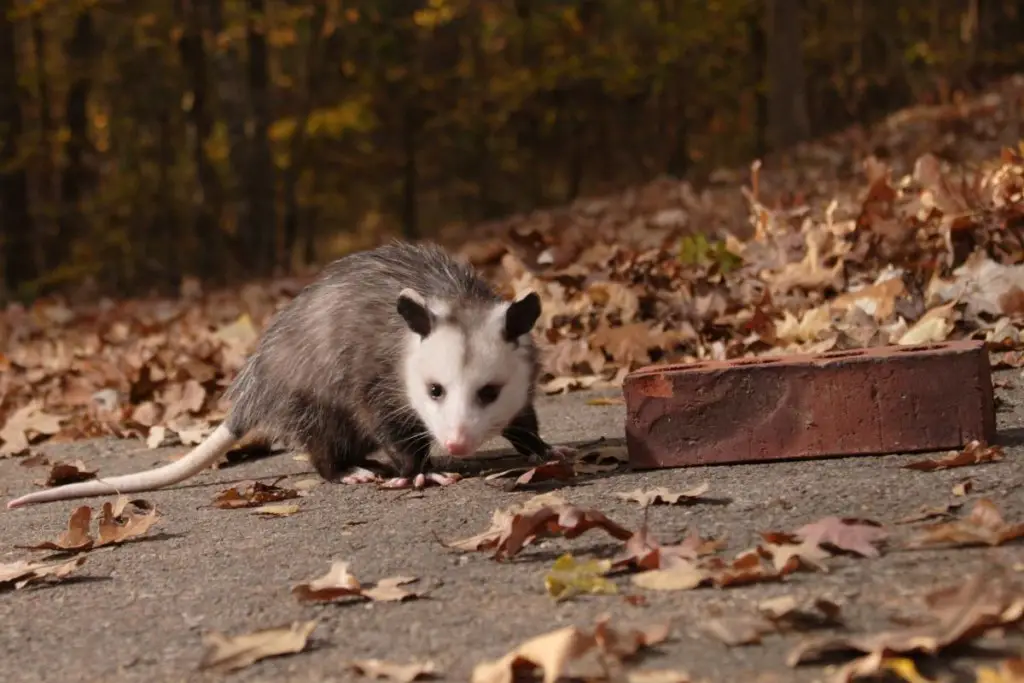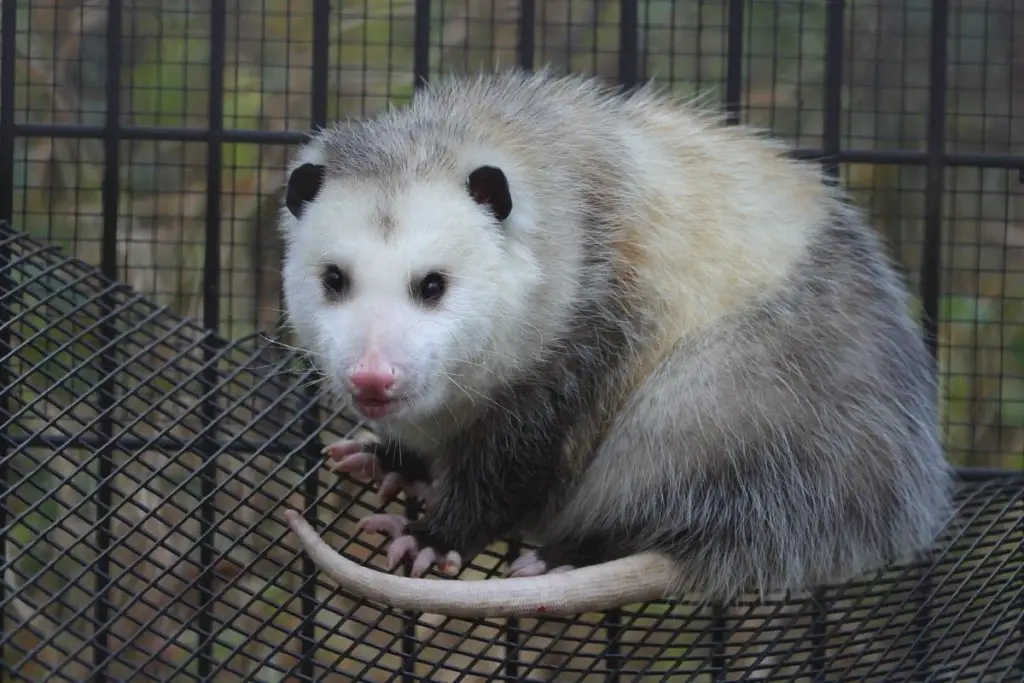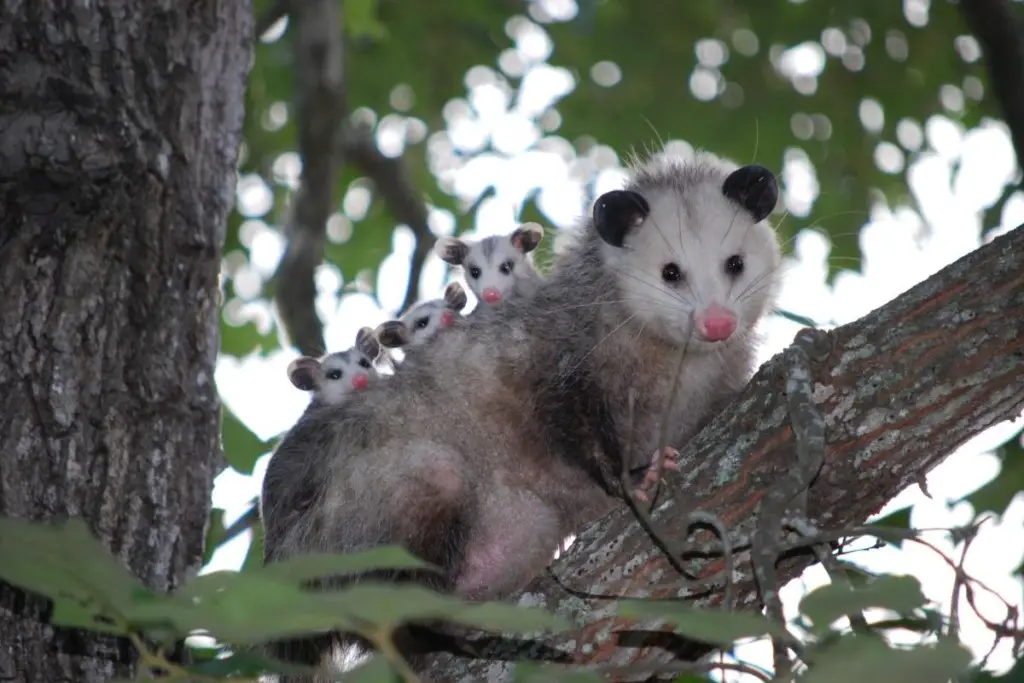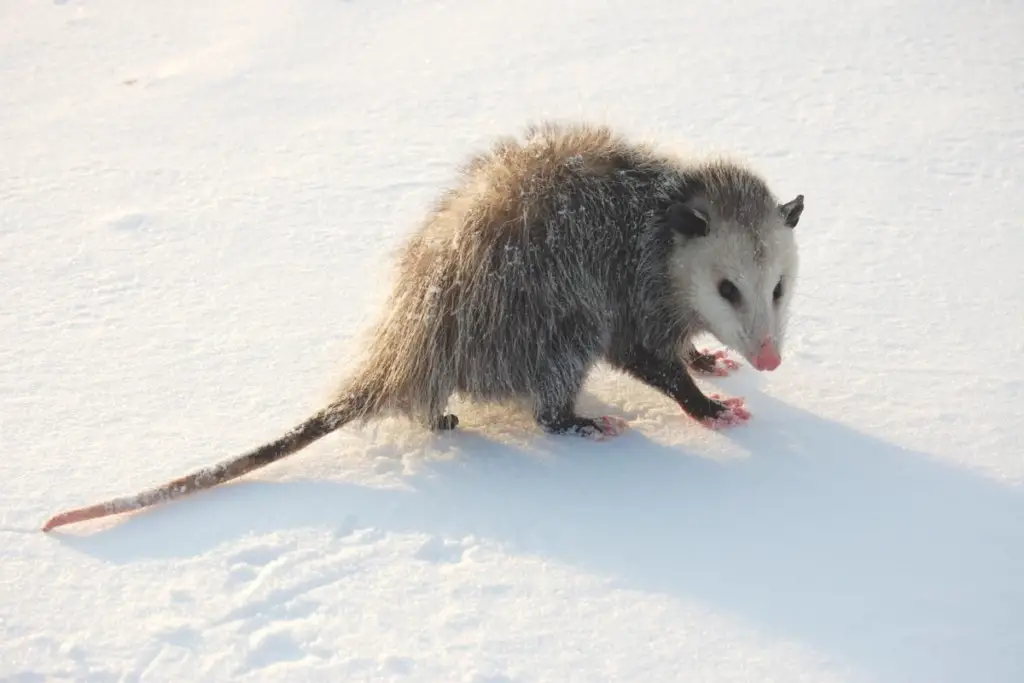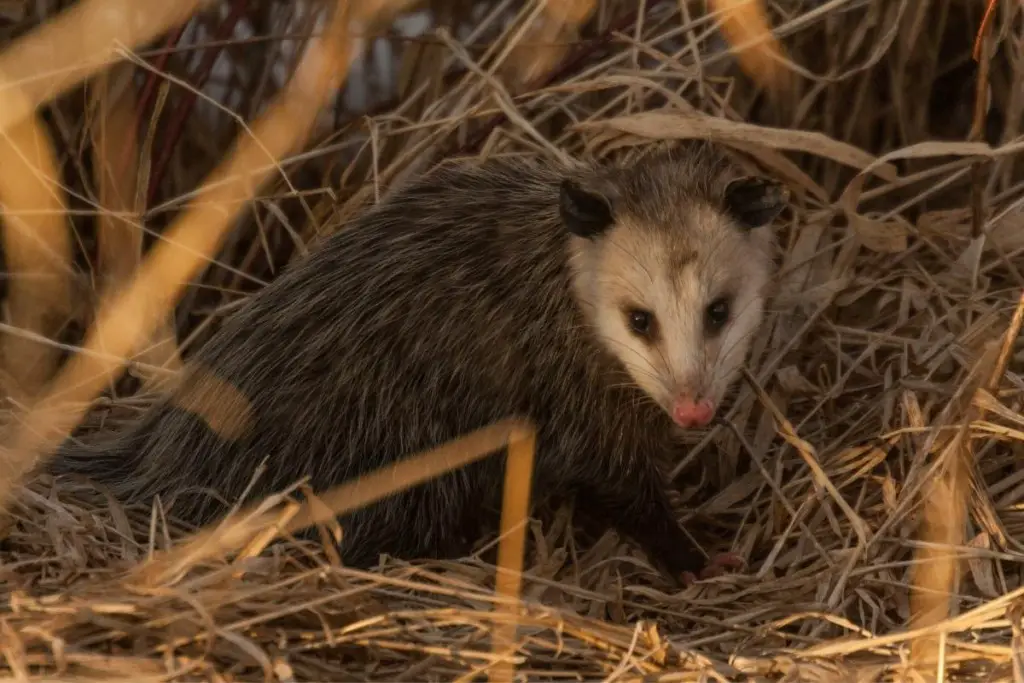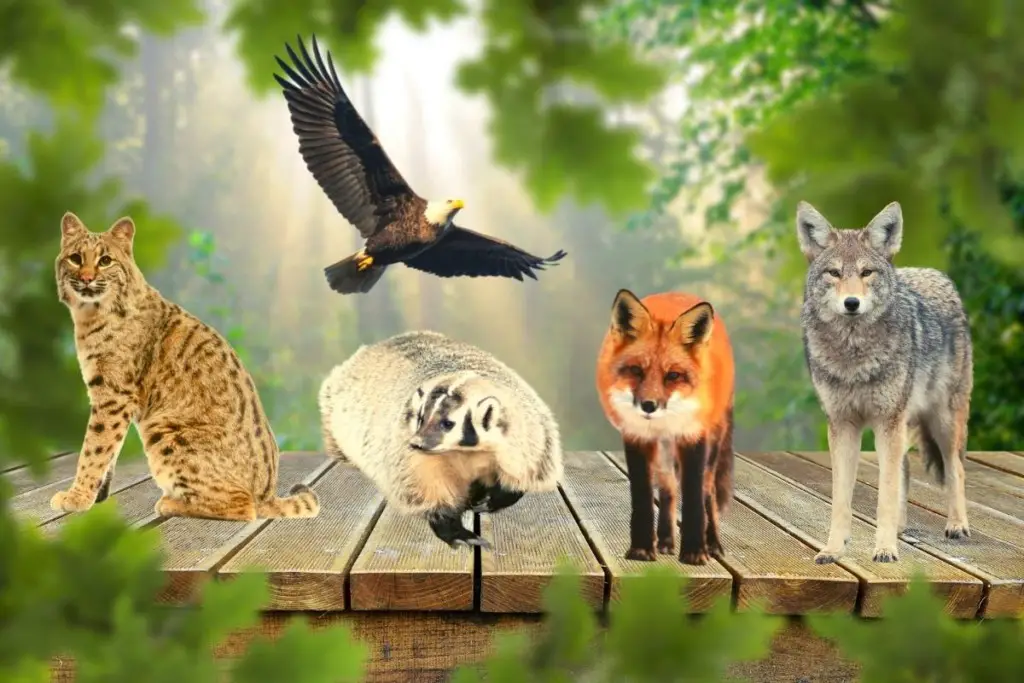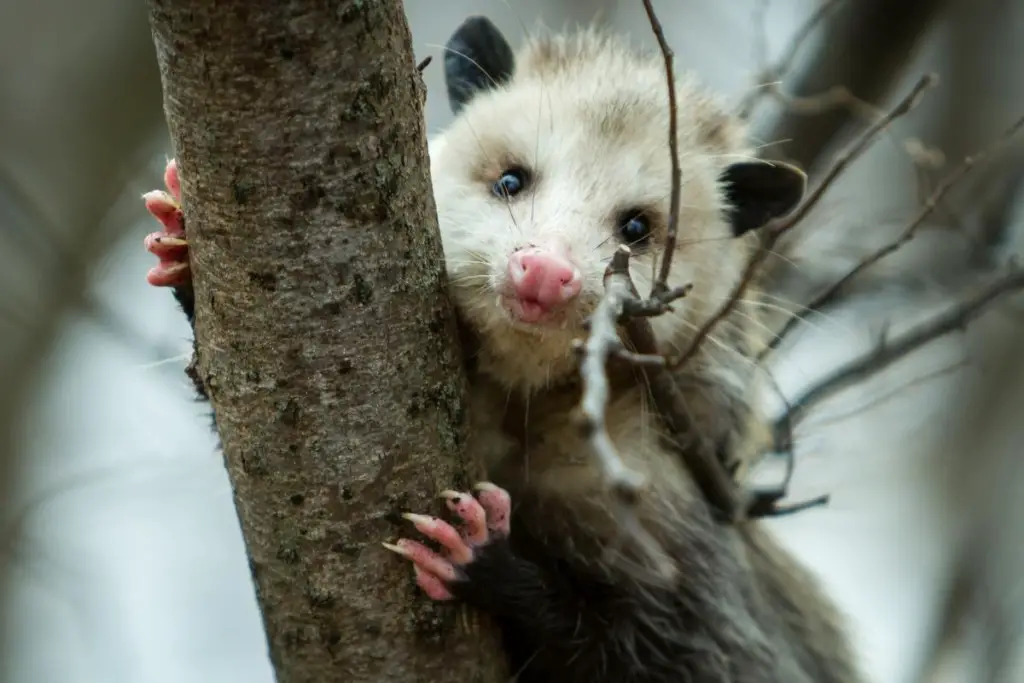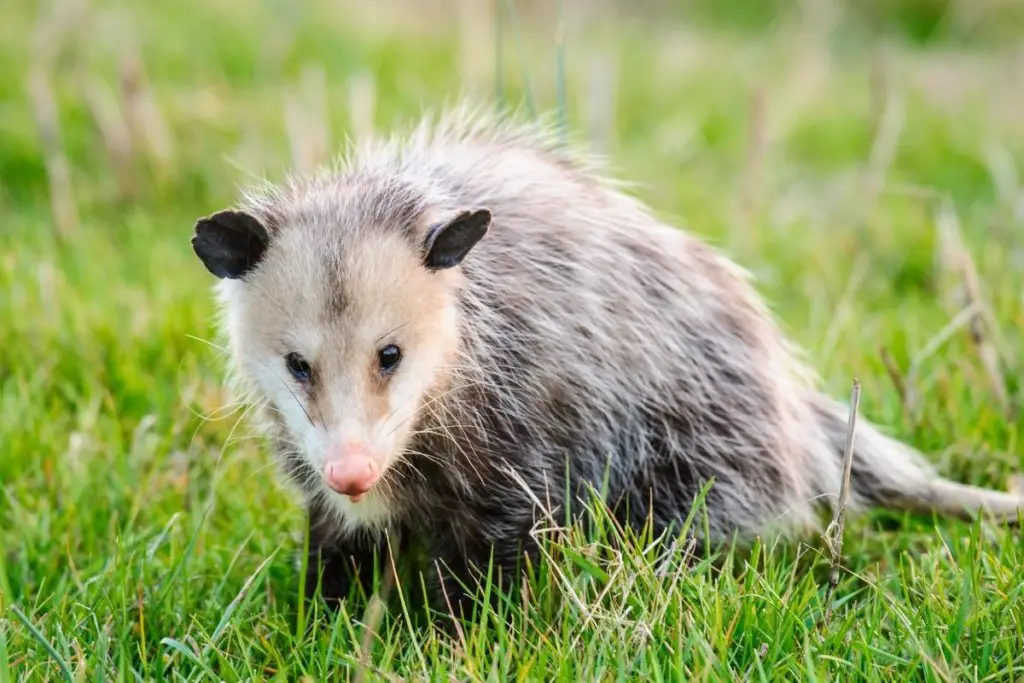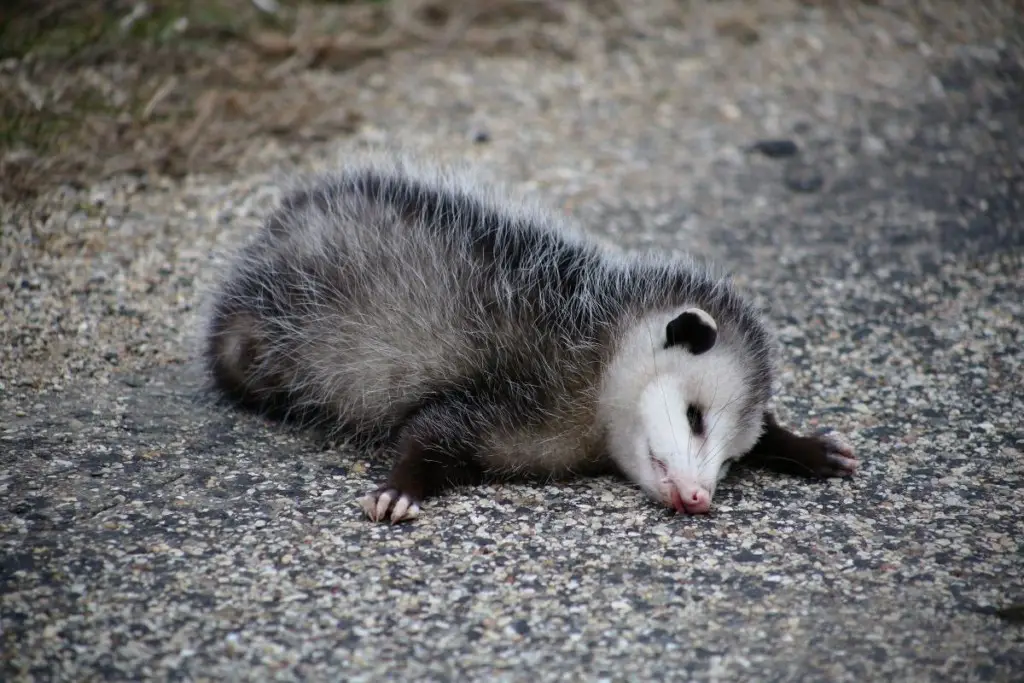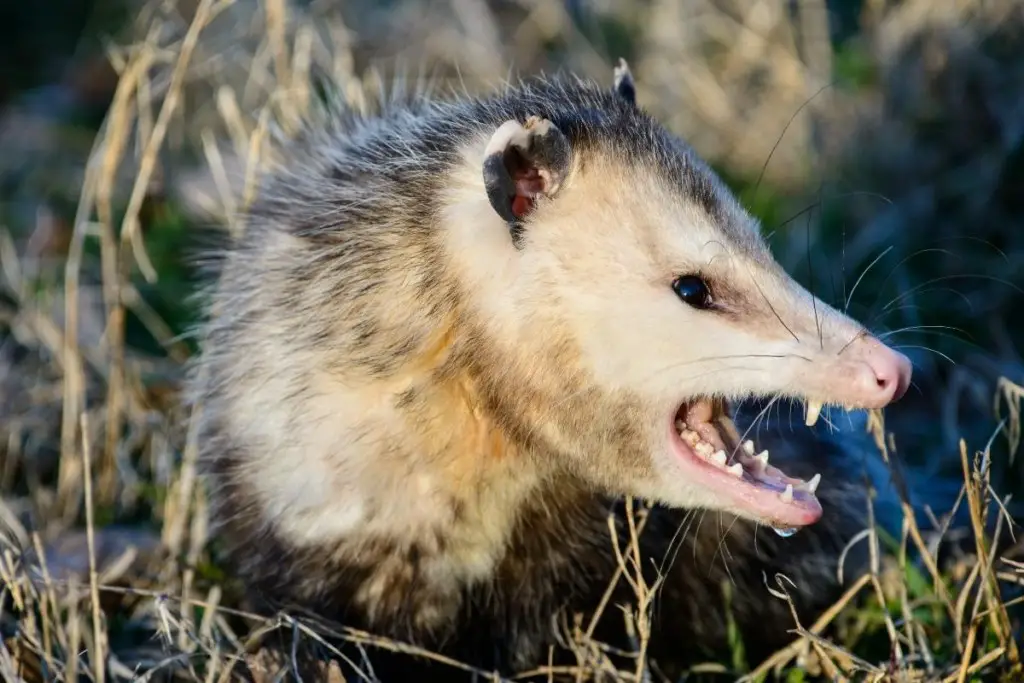The Virginia opossum (Didelphis Virginiana) is a marsupial that lives in North America. They are small mammals that have a pouch to carry their young. Opossums are the only marsupial found in the U.S. and Canada.
Virginia Opossum

| Animal Classifications | |
| Kingdom | Animalia |
| Phylum | Chordata |
| Class | Mammalia |
| Order | Didelphimorphia |
| Family | Didelphidae |
| Genus | Didelphis |
| Scientific Name | Didelphis Virginiana |
Let’s take a closer look at the Virginia opossum, where they live, how they live, and what makes them different from other animals in North America. Even though the opossum is technically different than the Australian possum, opossum is sometimes still pronounced without the “O”.
For the full story check out our article: Opossum Vs Possum
Opossum Distribution

Opossums live all around us. They were once contained in the southeastern United States. Now you find them from the tip of Texas all the way north through Michigan. From the east coast to the west coast. Chances are you’ve even seen a possum.
Never seen an opossum before? You may want to read our article: What Do Opossums Look Like
Unlike many other animals, opossums have the ability to thrive in areas shared with humans. Their ability to use a wide range of resources and environments makes the opossum a survival specialist.
The opossum is nocturnal and hunts primarily at night. Opossums can sometimes be crepuscular as well. You can read more about this in Are Opossums Nocturnal?
The possum shares it territory with many types of predators. This means that opossums are preyed on by animals higher up in the food chain, such as coyotes. The types of predators that will hunt an opossum are the ones that will be out in the night, since that is when opossums are most active.
Curious about what other animals eat an opossum? We think you will like to read our article: What Eats an Opossum
The Virginia opossums lives in many different types of regions. One of their favorite things to do is climb trees. They utilize their tail to help them climb things, and in a young age, are even known to be able to support themselves by hanging from their tails.
Want to see pictures of opossums in trees? Visit our article: Do Opossums Climb Trees?
Opossum Pouch
Opossums are unique among mammals, especially in the North American continent. One of the things that make the Virginia opossum so unique, is the fact that it’s a marsupial. This means that they carry their young in a pouch much like a kangaroo does! However, opossums are the only marsupial in North America.
Life for a newborn opossum is tough. For example, opossums may give birth to as many as twenty-five babies, but less than half of them survive. Opossums only have thirteen nipples, so if one of the newborn babies does not find a teat to latch on to, then it will almost surely die. In fact, only 10% will ever make it past one year.
And yet, while they do not seem to have very good odds individually, the whole of the species does very well in keeping their numbers up. This is due, largely, to the fact that they have a short gestation period and can have up to three litters a year.
Found this interesting? We thought you would! Want more? Try reading 10 Opossum Facts That Will Stump You

Do Possums Have Pouches?
Marsupials are part of the mammalian infraclass Marsupialia. Marsupials include the bandicoot, the wombat, the kangaroo, the koala, and many others. There are more than 250 species of marsupials. Most species live in Australia, New Guinea, and neighboring islands.
Unlike other mammals, marsupials, like the opossum, do not have a placenta. The baby opossums are born early in their development and are basically embryos at birth. After the tiny opossums (about 1/2 inch long) are born they climb up the mother’s abdomen with a swimming motion to the mother’s marsupium or brood pouch.
Not all marsupials have such a well-developed pouch as opossums do. Some have just a small flap of skin and still, some have no pouch at all.
Full-grown Virginia opossums weigh around 5-12 pounds. Want to read more about their size? Read: How Big is an Opossum
Are Opossums Born In the Pouch?
While mature opossums are solitary animals, mother opossums spend a lot of time caring for their babies. Another trait found in marsupials, like the opossum, is the forked (bifurcated) reproductive tract of the females.
Female opossums have two birth canals and two uteri. Likewise, males of the species have a bifurcated penis which gave rise to the myth that conception occurred through the female’s nose.
The myth states that she would then sneeze her young into the pouch. This, of course, is not the case. Baby opossums are not born in the pouch but come into the world as all mammals do, then make their way up to the pouch where they will remain for sixty to seventy days.
When the mother opossum gives birth she sits upright. It was once thought that the newborns found their way to the mother’s pouch by way of negative geotropism. That is to say that they moved away from the earth’s gravity.
This was dis-proven, however, by the fact that opossums didn’t develop internal and external ear organs until the forty-first day after conception. So at birth, the babies had no semicircular canals to detect gravity.
It was observed that the embryonic-like young had a large head and well-developed front legs which allowed them to make their way up but not down. Source.
Did you know opossum babies are called Joeys? Want to learn more? Here’s an article we think you’ll like: Opossum Babies Ultimate Guide
Do Male opossums Have Pouches?
The Virginia Opossum males do not have a pouch and neither do the bushy-tailed possums of Australia.
The male water opossum of South America has a pouch. They are the only marsupials adapted to an aquatic environment. While the male of this species does not carry young, he can carry food in his pouch. It also serves to protect his genital region from the water.
Another South American species, the short-tailed opossum, does not have a well-defined pouch in either the male or the female. Instead, the female has just a rudimentary flap of skin.

Opossum Pouch Anatomy | Inside Opossum Pouch
The mother opossum can open and close her pouch by way of muscle contraction. The young developing opossums stay connected to the nipple of the highly mobile mother by using their fetal tongue and strong facial muscles.
Opossum pouches are lined with fur. Once the young are in the pouch they will remain permanently attached to the same teat for about the first sixty days. This is known as the fixation period.
If the baby opossums are removed from this teat, the forming mouths are torn and the young are unable to reattach themselves because the definitive lips have yet to form. The female Virginia opossum has a well-developed pouch that contains thirteen nipples. The nipples are arranged in two arches of six with one nipple in the center.
The size of the opossum’s pouch depends on whether or not she is carrying young. The pouch is relatively small and shallow when she is not carrying baby opossums. The size of the pouch expands as she has her first litter. The pouch becomes much smaller after the little ones are weaned but never returns to the same size as it was prior to the first pregnancy. Source.
If you find opossum pouch anatomy interesting, you might also like to read: Opossum Skeleton
Opossum Benefits | Virginia Opossum
Mostly, opossums are seen as scavengers and nuisance animals. You might be surprised to learn that they offer many benefits to the environments and ecosystems where they live. Aside from the local environmental benefits, they also offer a worldwide benefit for their role in medical research.
Opossums Eat Unwanted Pests
Virginia opossums are considered unwanted pests to many people. In truth, however, they are beneficial to the ecosystem. They are really not that intrusive. Besides running and “playing possum” they may show their teeth and hiss, other than that they are not that big of a nuisance.
Did you know that opossums use death feigning (playing dead) as a survival technique? Read more about it here: Do Possums Play Dead?
The main benefit opossums offer is the high number of unwanted pests they consume. They keep their neighborhoods clear of an overabundance of rats and mice. This omnivorous mammal also eats cockroaches, beetles, slugs, and snails.
This benefits your garden by keeping these creepie crawlies in their bellies and off your plants. They also eat fruits and vegetables that have fallen and are very often diseased and rotting.
This behavior leads to another benefit of the opossum, seed dispersal. They are important to the ecology of various plant species through the dispersal of seeds. They also contribute to the natural reforestation of disturbed forest fragments.
An opossums diet is mainly beneficial. To read more about this subject see our article: What Do Opossums Eat?
Another unwanted animal they have on the menu is venomous snakes. Opossums have resistance to snake venom. This allows them to hunt and feed on poisonous snakes and decrease their numbers in the local habitat.
Also, Opossums eat dead animal carcasses thereby disposing of unwanted roadkill. And, while possums can get rabies, they are not as susceptible to this viral infection as many other mammals are. This means that they are less likely to spread the disease.
Opossums do sometimes get rabies. Want to read more about it? See article: Opossum Rabies
Non-beneficial Effects of Opossums
Because they adapt well to so many environments, opossums move between forested, urban, and rural environments frequently. Their relationship with domestic and farm animals is a source of concern.
The direct, and indirect contact opossums have with these animals, transmit parasites. Fleas and ticks are the most common. In turn, fleas and ticks carry their own parasites for which opossums can also be a host.
Did you know that Opossums live in nests? To learn more about where opossums make their dens read: Opossum Nests
Tapeworms and other endoparasites can live in opossums and the fleas and ticks they carry. These can be transmitted to domestic animals like cats and dogs.
Single-celled protozoan parasites are known to cause severe and fatal neurological diseases in horses. In North America, this is the main concern when talking about opossums and the spread of disease. Source.
Curious to learn more about opossums? Here’s an article we think you will enjoy. Read What Do Opossums Sound Like?

Do Opossums Eat Ticks?
It has been reported that opossums eat as many as 5,000 ticks in one season. A 2009 study by the Royal Society Researchers estimated that opossums killed 83-96% of the ticks that tried to attach and feed. This may not be the case, however.
New studies show that stomach contents of wild opossums show little to no evidence of ticks and their body parts. They questioned the methods of the previous study, noting that they did not examine the animals for ticks still attached at the end of the study.
Curious about where you can find opossums? Try reading: Where Do Opossums Live
That is not to say that opossums don’t eat ticks. Being the omnivorous animals that they are, they are not likely to pass up a free meal. So even if these animals don’t readily devour ticks on the scale that was once proposed, that doesn’t mean that they don’t do their part for the environment (like consuming or otherwise disposing of their fair share of ticks).
Want to learn more about the Opossum’s environment? Check out our article: Opossum Habitat
Opossums in Medical Research
Marsupials are mammals that split from our evolutionary family tree around 148 million years ago. The main observable difference between marsupials like the opossum and other mammals is the fact that they either don’t have a placenta or they have a placenta with very limited functionality that is short-lived.
Ever wonder how long opossums live for? You may want to check out our article: Opossum Life Cycle
This is not the only difference, however. Conversely, there are many similarities opossums share with people and other species of mammals that are useful to the scientific community.
Did you know opossums have 5 digits on their feet? If you want to learn how to recognize opossum footprints see our article: Opossum Tracks
One similarity shared between opossums and people is the fact they develop skin cancer. They are the only animals other than humans that develop melanoma caused by UV light.
Another similarity is x-chromosome inactivation. Everyone has two pairs of sex chromosomes in each cell. Women have two X chromosomes and men have one X and one Y.
In women, one of the X chromosomes is randomly and permanently deactivated in cells other than eggs. Opossums share this genetic trait with humans and other mammals.
Did you know you can track animals by identifying their scat? For opossum tracking tips see our article: Opossum Poop
It is these differences and similarities in biology that allow scientists to contrast and compare divergent and convergent evolutionary processes. Source.
Many people wonder about raising an opossum as a pet. We do not suggest raising wild animals, while they can be tamed, they are not domesticated. However, we know people will still keep them as pets, so we made this guide to help those who need better information.
If you’re interested in opossums as pets see our article: Opossums as Pets
All Opossum Articles
Virginia Opossum
What Does an Opossum Sound Like (With Examples)
Opossum Skeleton | With Examples
What Do Opossums Eat? | Ultimate Guide
10 Opossum Facts That Will Stump You
Opossum Rabies
Opossum Size
What Do Possums Look Like?
Opossum Habitat
Opossum Babies | The Ultimate Guide
Opossum Tracks | The Ultimate Guide
Opossum Nests | Opossum Dens
Opossum Poop | Ultimate Guide
Where Do Possums Live?
What Eats Possums? Opossum Predators
Do Possums Climb Trees?
How Long Do Opossums Live? Opossum Life Cycle
Do Possums Play Dead? Death-Feigning
Opossum Vs Possum | The Ultimate Guide
Opossums As Pets | Pet Opossum Care
Are Opossums Dangerous? The Absolute Answer
Are Opossums Nocturnal?
Conclusion
We hope you’ve learned a little bit about our friend the Virginia Opossum. They are animals that have adapted very well in North America, despite having terrible vision, and the size to defend themselves from large prey.
While they may grunt, show their teeth, and even hiss, they are small harmless creatures. This doesn’t mean you should try to approach one, if you find yourself face to face with an opossum, avoid making content, and watch them from a distance.
Are opossums a threat? They are wild animals so they can be unpredictable, read more about them here: Are Opossums Dangerous
- Hero Farm Dog Survives Epic Battle with Coyote Pack - December 9, 2024
- The 10-Minute Bedtime Routine That Changed My Dog’s Sleep Forever - November 29, 2024
- Creating a Safe Space for Nervous Pets: Your Guide to Pet-Friendly Havens - November 25, 2024


